Sir Arthur’s Future (1964)
Wednesday, April 11th, 2012Remarkable and fantastic predictions from Sir Arthur C. Clarke, via the BBC programme “Horizon” from 1964.
Part 1
Part 2
Remarkable and fantastic predictions from Sir Arthur C. Clarke, via the BBC programme “Horizon” from 1964.
Part 1
Part 2
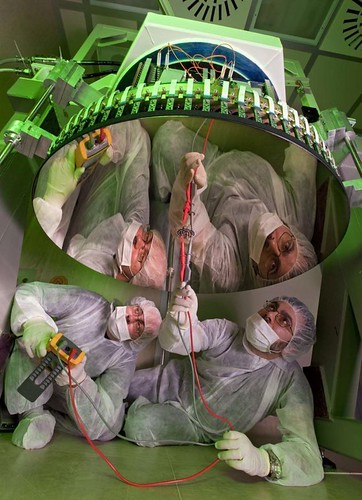
The images captured by the Large Binocular Telescope Observatory in Arizona may not seem like much to us common folk, but to serious astronomers this is hot stuff. And with language such as “previously impossible discoveries” used in their press release, this is no casual piece of news.
And this is the best ever taken of four young stars in the Orion Trapezium cluster?
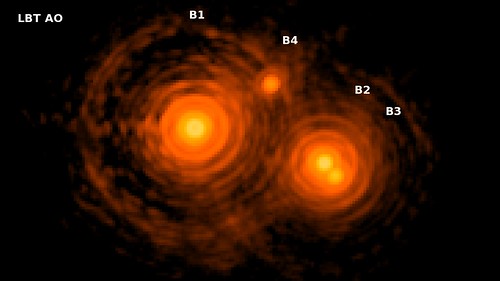
A view of four young stars in the Orion Trapezium cluster 1,350 light-years away, as seen through the LBT’s Adaptive Optics (AO). This is the best image ever taken of these stars, which are all tightly located within 1 arcsecond of each other. By comparing this 2.16 micron infrared image to past images of this group over the last 15 years, astronomers can now see the motion of each star with respect to the others. The movements show that the mini-cluster of young stars were born together, but will likely fall apart as the stars age and interact with each other.
These may not be the kind of gorgeous images (suitable for framing) we’re usually getting excited about. For the astronomers associated with this observatory — and all those who’ll benefit from this technology in the future — these images are amazing and show break-through scientific advances at their best.
No relation to the Canadian rock band BTO (Bachman Turner Overdrive), although their music could make the LBTO videos more exciting to watch.
Came across a really cool story last week on TCU 360…
Reaching for the stars is not a far stretch for astronomy students and graduates involved in the latest Apache Point Observatory Galactic Evolution Experiment project.
The project grants students access to as many as 300 star clusters at once that have never been visible in this capacity and clarity, assistant professor of physics and astronomy Peter Frinchaboy said.
Frinchaboy said he worked for the past two-and-a-half years to get the university access to APOGEE, which is a part of the Sloan Digital Sky Survey III project. The total scope of the APOGEE project includes over 300 scientists from around the world and collaboration with other universities and research institutes, he said.

The Sloan Digital Sky Survey is quite an effort — and the potential it holds for astronomers’ studies is astounding.
The SDSS telescope’s image viewing tool is pretty cool, too.
Take, for example, Messier 51 — The Whirlpool Galaxy…
”]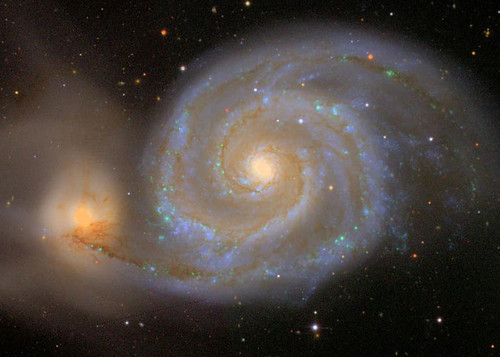
–
In February, 1990, Voyager-1 turned around and took its last photo of Earth — from 4 billion miles away. That photo opens this video. The late astronomer Carl Sagan wrote the accompanying narrative, putting everything in perspective.
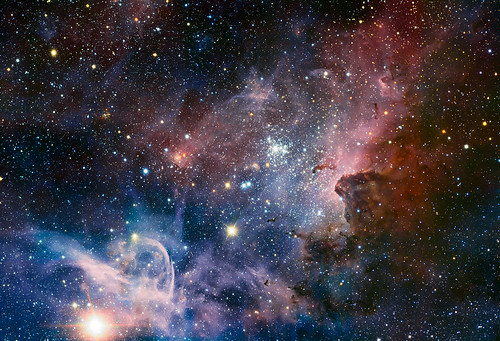
Awesome image from the European South Observatory (image credit: ESO/T. Preibisch)…
This broad panorama of the Carina Nebula, a region of massive star formation in the southern skies, was taken in infrared light using the HAWK-I camera on ESO’s Very Large Telescope. Many previously hidden features, scattered across a spectacular celestial landscape of gas, dust and young stars, have emerged.
Sit back a watch this “trailer” about the VLT (Very Large Telescope)…
Get yourself a huge piece to hang on your wall at Big Bang Prints. Good stuff!

After a very nice Super Bowl yesterday, those of us who spent the time watching eating and drinking massive quantities of stuff we shouldn’t, may be dealing with remnants on another kind of bowl.
How appropriate that today’s Image of the Day from NASA is “Remnant of A Supernova” (G350.1+0.3)…
Vital clues about the devastating ends to the lives of massive stars can be found by studying the aftermath of their explosions. In its more than twelve years of science operations, NASA’s Chandra X-ray Observatory has studied many of these supernova remnants sprinkled across the galaxy.
The latest example of this important investigation is Chandra’s new image of the supernova remnant known as G350.1+0.3. This stellar debris field is located some 14,700 light years from the Earth toward the center of the Milky Way.
Evidence from Chandra and from ESA’s XMM-Newton telescope suggest that a compact object within G350.1+0.3 may be the dense core of the star that exploded. The position of this likely neutron star, seen by the arrow pointing to “neutron star” in the inset image, is well away from the center of the X-ray emission. If the supernova explosion occurred near the center of the X-ray emission then the neutron star must have received a powerful kick in the supernova explosion.
Data suggest this supernova remnant, as it appears in the image, is 600 and 1,200 years old. If the estimated location of the explosion is correct, this means the neutron star has been moving at a speed of at least 3 million miles per hour since the explosion.
Another intriguing aspect of G350.1+0.3 is its unusual shape. Many supernova remnants are nearly circular, but G350.1+0.3 is strikingly asymmetrical as seen in the Chandra data in this image (gold). Infrared data from NASA’s Spitzer Space Telescope (light blue) also trace the morphology found by Chandra. Astronomers think that this bizarre shape is due to stellar debris field expanding into a nearby cloud of cold molecular gas.
The age of 600-1,200 years puts the explosion that created G350.1+0.3 in the same time frame as other famous supernovas that formed the Crab and SN 1006 supernova remnants. However, it is unlikely that anyone on Earth would have seen the explosion because of the obscuring gas and dust that lies along our line of sight to the remnant.
These results appeared in the April 10, 2011 issue of The Astrophysical Journal.
Image Credits: X-ray: NASA/CXC/SAO/I. Lovchinsky et al; IR: NASA/JPL-Caltech
The description references the “Crab Nebula” — get your prints here.
Red Aurora Australis from Alex Cherney on Vimeo.
After chasing it for more than two years I was finally rewarded with two displays of Auroa Australis (Southern lights) within a week visible from Mornington peninsula, not far from Melbourne. The nights were warm an clear and the Moon was not in the sky either – I could not have asked for better conditions.
The red color of this aurora is caused by the charged particles from the Sun exciting oxygen atoms high in the Earth’s atmosphere. Hopefully there will be more to come as Sun’s activity increases in 2012-13.
Being able to photograph it all night I came up with a nice video. The brighter Aurora happened on January 22nd and the smaller one, featured in the middle section, was from January 16th, followed by a rather bright Moonrise.

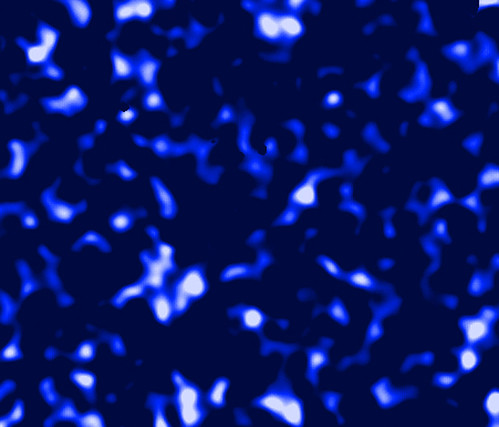
Last week, while many were awaiting news of fresh electro-gadgets from the CES in Las Vegas, The American Astronomical Society held its 219th meeting in Austin.
At the meeting, research was presented on a vast, one-billion-light-year-wide map showing lots of dark matter…
Astronomers have created a vast cosmic map revealing an intricate web of dark matter and galaxies spanning a distance of one billion light-years.
This unprecedented task was achieved not by observing dark matter directly, but by observing its gravitational effects on ancient light traveling from galaxies that existed when the Universe was half the age it is now.
Constructed by astronomers from the University of British Columbia and University of Edinburgh, this is the largest dark matter map ever built and took five years to complete.
The research was presented at the American Astronomical Society meeting in Austin, Texas, on Monday.
Dark matter pervades the entire observable universe, accounting for 83 percent of the mass of the cosmos. But as it does not scatter or radiate light (or any kind of electromagnetic radiation for that matter), we cannot see it. Naturally, this poses an interesting problem for astronomers hoping to map the stuff.
However, astronomers can indirectly observe dark matter as its mass exerts a gravitational force on the space-time surrounding it. As light travels from distant galaxies, it will be bent around gravitational distortions in space-time — much like the paths of marbles rolling across a bent sheet of plastic — being caused by the dense regions of dark matter.
With this in mind, the international team of astronomers analyzed light from 10 million galaxies in four different regions of the sky — all of which are around 6 billion light-years from Earth.
And the CES? It wasn’t much fun, according to Pogue…
C.E.S. really is primarily a deafening showcase for tablets, thin TV screens, superthin laptops and Android phones.
Check it out: the universe is 96% dark matter.
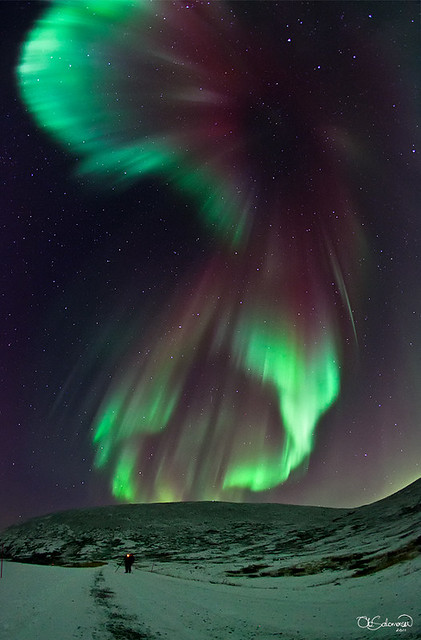
Of all the countries of the world, I always thought the Kingdom of Norway would be a great place to live. As long as you can deal with the long winters, pretty much all else is taken care of. With the highest per capital oil production of any country outside the Middle East, your cost for education is zero. Gasoline prices are pretty high — to keep consumption down. Why go anywhere by car when you could walk, bike or sled?
In the northern parts, particularly Tromsø (“the capital of the Arctic” — tourist site offers only summer pics), the Northern Lights provide enough entertainment to last a lifetime. No need for a telescope here — low light pollution and the most spectacular visuals.
Today’s APOD by Ole Christian Salomonsen is just that: spectacular!
Explanation: It was one of the most memorable auroras of the season. There was green light, red light, and sometimes a mixture of the two. There were multiple rays, distinct curtains, and even an auroral corona. It took up so much of the sky. In the background were stars too numerous to count, in the foreground a friend trying to image the same sight. The scene was captured with a fisheye lens around and above Tromsø, Norway, last month. With the Sun becoming more active, next year might bring even more spectacular aurora.
One of these days, a vacation in Norway awaits.
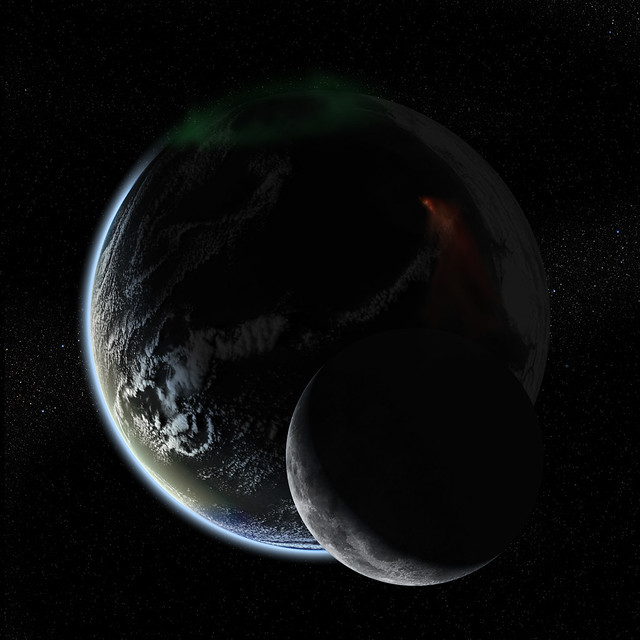
Located 20.5 light years away (123 trillion miles), Gliese 581g has a 100% chance of sustaining life. The planet is located in the “Goldilocks” zone, which is considered habitable. If you used a rocket traveling at 1/10 the speed of light (19,000 MPH), it would take 200 years to get there — who has time for that, Dave?
It was announced in September:
A team of planet hunters from the University of California (UC) Santa Cruz, and the Carnegie Institution of Washington has announced the discovery of a planet with three times the mass of Earth orbiting a nearby star at a distance that places it squarely in the middle of the star’s “habitable zone.”
This discovery was the result of more than a decade of observations using the W. M. Keck Observatory in Hawaii, one of the world’s largest optical telescopes. The research, sponsored by NASA and the National Science Foundation, placed the planet in an area where liquid water could exist on the planet’s surface. If confirmed, this would be the most Earth-like exoplanet yet discovered and the first strong case for a potentially habitable one.
To astronomers, a “potentially habitable” planet is one that could sustain life, not necessarily one where humans would thrive. Habitability depends on many factors, but having liquid water and an atmosphere are among the most important.
The new findings are based on 11 years of observations of the nearby red dwarf star Gliese 581 using the HIRES spectrometer on the Keck I Telescope. The spectrometer allows precise measurements of a star’s radial velocity (its motion along the line of sight from Earth), which can reveal the presence of planets. The gravitational tug of an orbiting planet causes periodic changes in the radial velocity of the host star. Multiple planets induce complex wobbles in the star’s motion, and astronomers use sophisticated analyses to detect planets and determine their orbits and masses.
Washington State’s Dirk Schulze-Makuch has a group of scientists working on it.
